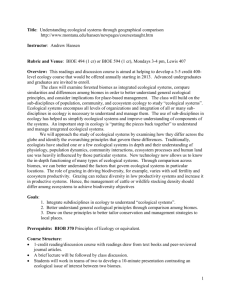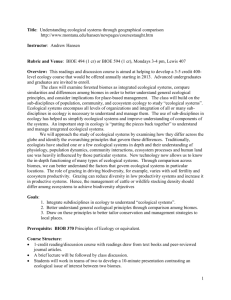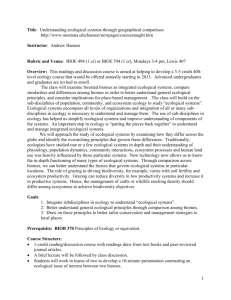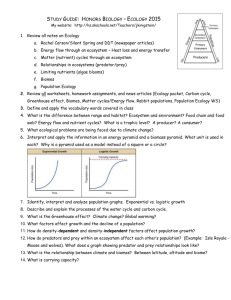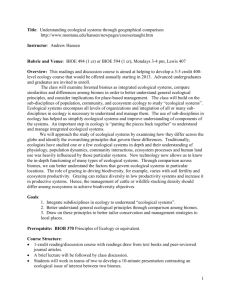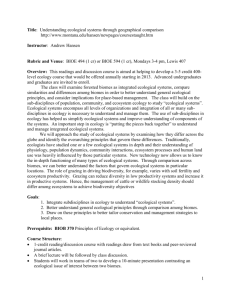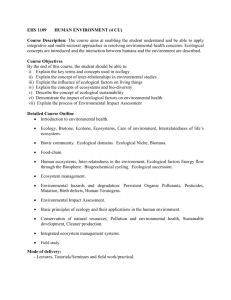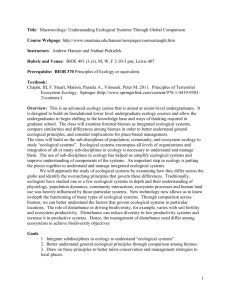Title: Understanding ecological systems through geographical
advertisement
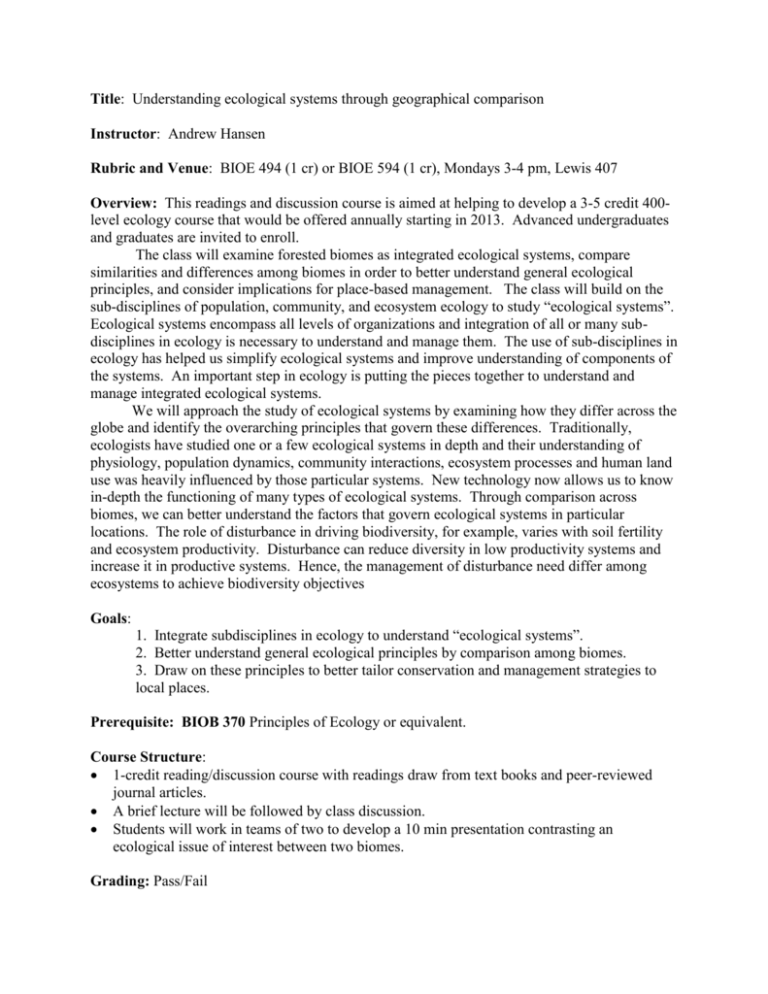
Title: Understanding ecological systems through geographical comparison Instructor: Andrew Hansen Rubric and Venue: BIOE 494 (1 cr) or BIOE 594 (1 cr), Mondays 3-4 pm, Lewis 407 Overview: This readings and discussion course is aimed at helping to develop a 3-5 credit 400level ecology course that would be offered annually starting in 2013. Advanced undergraduates and graduates are invited to enroll. The class will examine forested biomes as integrated ecological systems, compare similarities and differences among biomes in order to better understand general ecological principles, and consider implications for place-based management. The class will build on the sub-disciplines of population, community, and ecosystem ecology to study “ecological systems”. Ecological systems encompass all levels of organizations and integration of all or many subdisciplines in ecology is necessary to understand and manage them. The use of sub-disciplines in ecology has helped us simplify ecological systems and improve understanding of components of the systems. An important step in ecology is putting the pieces together to understand and manage integrated ecological systems. We will approach the study of ecological systems by examining how they differ across the globe and identify the overarching principles that govern these differences. Traditionally, ecologists have studied one or a few ecological systems in depth and their understanding of physiology, population dynamics, community interactions, ecosystem processes and human land use was heavily influenced by those particular systems. New technology now allows us to know in-depth the functioning of many types of ecological systems. Through comparison across biomes, we can better understand the factors that govern ecological systems in particular locations. The role of disturbance in driving biodiversity, for example, varies with soil fertility and ecosystem productivity. Disturbance can reduce diversity in low productivity systems and increase it in productive systems. Hence, the management of disturbance need differ among ecosystems to achieve biodiversity objectives Goals: 1. Integrate subdisciplines in ecology to understand “ecological systems”. 2. Better understand general ecological principles by comparison among biomes. 3. Draw on these principles to better tailor conservation and management strategies to local places. Prerequisite: BIOB 370 Principles of Ecology or equivalent. Course Structure: 1-credit reading/discussion course with readings draw from text books and peer-reviewed journal articles. A brief lecture will be followed by class discussion. Students will work in teams of two to develop a 10 min presentation contrasting an ecological issue of interest between two biomes. Grading: Pass/Fail Schedule Date Topic and Tentative Reading Jan 16 Martin Luther King Day (No Class) Jan 23 Conceptual models of ecological systems, Class orientation Pickett, S.T.A., J. Kolasa, C.G. Jones. 2007. Ecological Understanding: The Nature of Theory and the Theory of Nature. Elsevier, Boston. Chapter 1 Integration in Ecology, pgs 3-17, 27-32). Jan 30 Terrestrial forest biomes of the world Chapin, III, F. Stuart, Matson, Pamela A., Vitousek, Peter M. 2011. Principles of Terrestrial Ecosystem Ecology. Springer, New York. Chapter 2. Earth’s climate system, pgs 23-26, 30-62. Feb 6 Primary productivity: controls, patterns, consequences Chapin, III, F. Stuart, Matson, Pamela A., Vitousek, Peter M. 2011. Principles of Terrestrial Ecosystem Ecology. Springer, New York. Chapter 5. Carbon inputs to ecosystems, pgs 123-128, 134-156. Feb 13 Primary productivity: comparison among biomes Running, S. W., R. R. Nemani, F. A. Heinsch, Z. Zhao, M. Reeves, and H. Hashimoto. 2004. A continuous satellite derived measure of global terrestrial primary production. BioScience 54:547–560. Huston, M. A., and S. Wolverton. 2009. Ecological Monographs. Feb 20 President’s Day (No Class) Feb 27 Habitat complexity: controls, patterns, consequences Chapin, III, F. Stuart, Matson, Pamela A., Vitousek, Peter M. 2011. Principles of Terrestrial Ecosystem Ecology. Springer, New York. Chapter 13. Landscape heterogeneity and ecosystem dynamics, pgs 369-397. Mar 5 Habitat complexity: comparison among biomes TBA Mar 12 Spring Break (No Class) Mar 19 Trophic cascades: controls, patterns, consequences Chapin, III, F. Stuart, Matson, Pamela A., Vitousek, Peter M. 2011. Principles of Terrestrial Ecosystem Ecology. Springer, New York. Chapter 10. Trophic dynamics, pgs 297-320. Mar 26 Tropic cascades: comparison among biomes Estes, J. A., J. Terborgh, J. S. Brashares, M. E. Power, J. Berger, et al. 2011. Trophic downgrading of planet earth. Science 333:301-306. Melis, C., B. Jedrzejewska, M.Apollonio, K. A. Barton, W. Jedrzejewski, J. D. C. Linnell, I. Kojola, J. Kusak, M. Adamic, S. Ciuti, I. Delehan, I. Dykyy, K.Krapinec, L. Mattioli, A. Sagaydak, N. Samchuk, K. Schmidt, M. Shkvyrya, V. E. Sidorovich, B. Zawadzka, and S. Zhyla. 2009. Predation has a greater impact in less productive environments: variation in roe deer, Capreolus capreolus, population density across Europe. Global Ecology and Biogeography 18:724–734. Apr 2 Apr 9 Community diversity: controls, patterns, consequences Smith, R.L. 1996. Ecology and Field Biology, Fifth Edition. HarperCollins, NY. Pgs 603-607. Community diversity: comparison among biomes TBA Apr 16 Synthesis: Interactions among state variables across biomes TBA Apr 23 Synthesis: Grouping Biomes based on ecological properties Hansen A.J. In Review. Ecosystem energy as a framework for prioritizing conservation vulnerabilities and management strategies. Unpublished manuscript. Pgs 1-36. Apr 30 Student presentations
